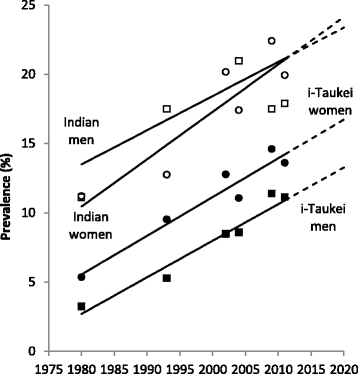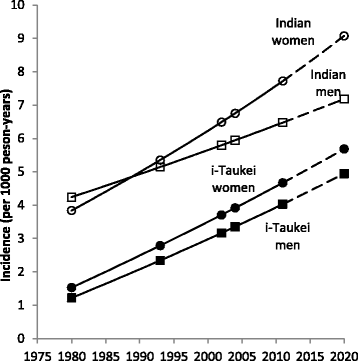Diabetes incidence and projections from prevalence surveys in Fiji
- PMID: 27905979
- PMCID: PMC5124232
- DOI: 10.1186/s12963-016-0114-0
Diabetes incidence and projections from prevalence surveys in Fiji
Abstract
Background: Type 2 diabetes mellitus (T2DM) incidence is traditionally derived from cohort studies that are not always feasible, representative, or available. The present study estimates T2DM incidence in Fijian adults from T2DM prevalence estimates assembled from surveys of 25-64 year old adults conducted over 30 years (n = 14,288).
Methods: T2DM prevalence by five-year age group from five population-based risk factor surveys conducted over 1980-2011 were variously adjusted for urban-rural residency, ethnicity, and sex to previous censuses (1976, 1986, 1996, 2009) to improve representativeness. Prevalence estimates were then used to calculate T2DM incidence based on birth cohorts from the age-period (Lexis) matrix following the Styblo technique, first used to estimate annual risk of tuberculosis infection (incidence) from sequential Mantoux population surveys. Poisson regression of year, age, sex, and ethnicity strata (n = 160) was used to develop projections of T2DM prevalence and incidence to 2020 based on various scenarios of population weight measured by body mass index (BMI) change.
Results: T2DM prevalence and annual incidence increased in Fiji over 1980-2011. Prevalence was higher in Indians and men than i-Taukei and women. Incidence was higher in Indians and women. From regression analyses, absolute reductions of 2.6 to 5.1% in T2DM prevalence (13-26% lower), and 0.5-0.9 per 1000 person-years in incidence (8-14% lower), could be expected in 2020 in adults if mean population weight could be reduced by 1-4 kg, compared to the current period trend in weight gain.
Conclusions: This is the first application of the Styblo technique to calculate T2DM incidence from population-based prevalence surveys over time. Reductions in population BMI are predicted to reduce T2DM incidence and prevalence in Fiji among adults aged 25-64 years.
Keywords: Developing country; Fiji; Incidence; Obesity; Pacific islands; Prevalence; Trends; Type 2 diabetes mellitus.
Figures


Similar articles
-
Diabetes and obesity trends in Fiji over 30 years.J Diabetes. 2016 Jul;8(4):533-43. doi: 10.1111/1753-0407.12326. Epub 2015 Sep 15. J Diabetes. 2016. PMID: 26201444
-
Absolute cardiovascular risk in a Fiji medical zone.BMC Public Health. 2016 Feb 9;16:128. doi: 10.1186/s12889-016-2806-6. BMC Public Health. 2016. PMID: 26861211 Free PMC article.
-
Diabetes incidence and projections from prevalence surveys in Samoa over 1978-2013.Int J Public Health. 2017 Jul;62(6):687-694. doi: 10.1007/s00038-017-0961-x. Epub 2017 Mar 9. Int J Public Health. 2017. PMID: 28280865 Free PMC article.
-
Diabetes and Obesity Trends in Tonga Over 40 Years.Asia Pac J Public Health. 2016 Sep;28(6):475-85. doi: 10.1177/1010539516645156. Epub 2016 Apr 27. Asia Pac J Public Health. 2016. PMID: 27122623 Review.
-
Overview of trends in cardiovascular and diabetes risk factors in Fiji.Ann Hum Biol. 2018 May;45(3):188-201. doi: 10.1080/03014460.2018.1465122. Ann Hum Biol. 2018. PMID: 29877150 Review.
Cited by
-
Changes in proportional mortality from diabetes and circulatory disease in Mauritius and Fiji: possible effects of coding and certification.BMC Public Health. 2019 May 2;19(1):481. doi: 10.1186/s12889-019-6748-7. BMC Public Health. 2019. PMID: 31046741 Free PMC article.
-
Response to comments by Hoyer and Brinks (2017) on: 'Diabetes incidence and projections from prevalence surveys in Samoa over 1978-2013'.Int J Public Health. 2018 Jan;63(1):153-154. doi: 10.1007/s00038-017-1042-x. Epub 2017 Oct 30. Int J Public Health. 2018. PMID: 29085958 No abstract available.
-
Worldwide impact of disease attributable to low physical activity for diabetes and kidney diseases.Front Endocrinol (Lausanne). 2025 May 5;16:1499381. doi: 10.3389/fendo.2025.1499381. eCollection 2025. Front Endocrinol (Lausanne). 2025. PMID: 40391013 Free PMC article.
-
Global, regional, and national trends in type 2 diabetes mellitus burden among adolescents and young adults aged 10-24 years from 1990 to 2021: a trend analysis from the Global Burden of Disease Study 2021.World J Pediatr. 2025 Jan;21(1):73-89. doi: 10.1007/s12519-024-00861-8. Epub 2025 Jan 3. World J Pediatr. 2025. PMID: 39752048 Free PMC article.
-
Comment on: "Diabetes incidence and projections from prevalence surveys in Samoa over 1978-2013".Int J Public Health. 2017 Jul;62(6):695-696. doi: 10.1007/s00038-017-0974-5. Epub 2017 Apr 27. Int J Public Health. 2017. PMID: 28451723 No abstract available.
References
-
- Soderberg S, Zimmet P, Tuomilehto J, de Courten M, Dowse GK, Chitson P, et al. High incidence of type 2 diabetes and increasing conversion rates from impaired fasting glucose and impaired glucose tolerance to diabetes in Mauritius. J Intern Med. 2004;256:37–47. doi: 10.1111/j.1365-2796.2004.01336.x. - DOI - PubMed
-
- AIHW Australian Institute of Health and Welfare . Insulin-treated treated diabetes in Australia 2000-2007. Diabetes series no. 11. Cat. No. CVD 45. Canberra: Australian Institute of Health and Welfare; 2009.
Publication types
MeSH terms
LinkOut - more resources
Full Text Sources
Other Literature Sources
Medical

